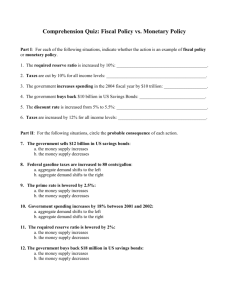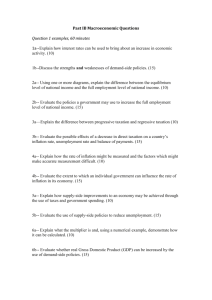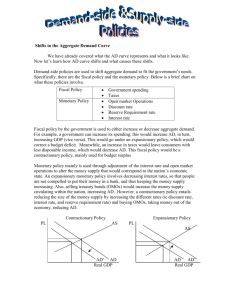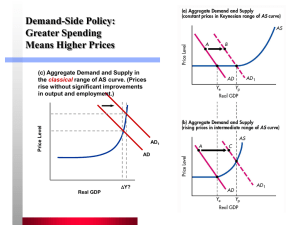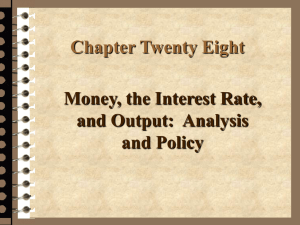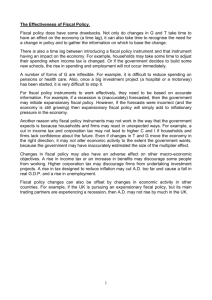Good/Bad Supply-side and Demand
advertisement
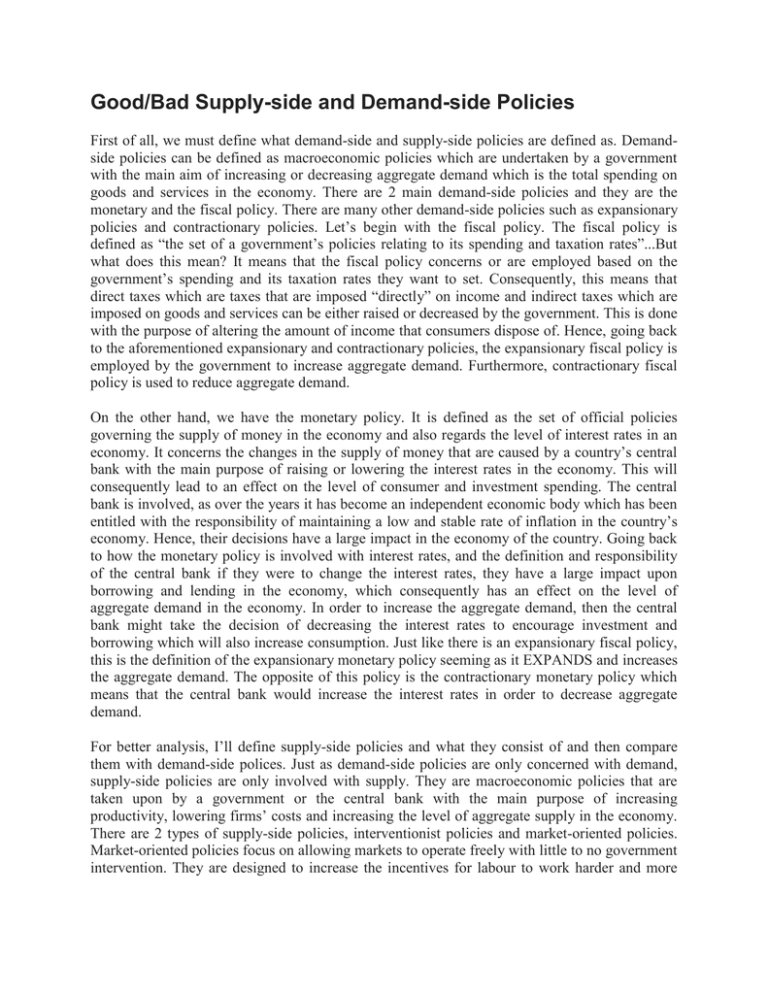
Good/Bad Supply-side and Demand-side Policies First of all, we must define what demand-side and supply-side policies are defined as. Demandside policies can be defined as macroeconomic policies which are undertaken by a government with the main aim of increasing or decreasing aggregate demand which is the total spending on goods and services in the economy. There are 2 main demand-side policies and they are the monetary and the fiscal policy. There are many other demand-side policies such as expansionary policies and contractionary policies. Let’s begin with the fiscal policy. The fiscal policy is defined as “the set of a government’s policies relating to its spending and taxation rates”...But what does this mean? It means that the fiscal policy concerns or are employed based on the government’s spending and its taxation rates they want to set. Consequently, this means that direct taxes which are taxes that are imposed “directly” on income and indirect taxes which are imposed on goods and services can be either raised or decreased by the government. This is done with the purpose of altering the amount of income that consumers dispose of. Hence, going back to the aforementioned expansionary and contractionary policies, the expansionary fiscal policy is employed by the government to increase aggregate demand. Furthermore, contractionary fiscal policy is used to reduce aggregate demand. On the other hand, we have the monetary policy. It is defined as the set of official policies governing the supply of money in the economy and also regards the level of interest rates in an economy. It concerns the changes in the supply of money that are caused by a country’s central bank with the main purpose of raising or lowering the interest rates in the economy. This will consequently lead to an effect on the level of consumer and investment spending. The central bank is involved, as over the years it has become an independent economic body which has been entitled with the responsibility of maintaining a low and stable rate of inflation in the country’s economy. Hence, their decisions have a large impact in the economy of the country. Going back to how the monetary policy is involved with interest rates, and the definition and responsibility of the central bank if they were to change the interest rates, they have a large impact upon borrowing and lending in the economy, which consequently has an effect on the level of aggregate demand in the economy. In order to increase the aggregate demand, then the central bank might take the decision of decreasing the interest rates to encourage investment and borrowing which will also increase consumption. Just like there is an expansionary fiscal policy, this is the definition of the expansionary monetary policy seeming as it EXPANDS and increases the aggregate demand. The opposite of this policy is the contractionary monetary policy which means that the central bank would increase the interest rates in order to decrease aggregate demand. For better analysis, I’ll define supply-side policies and what they consist of and then compare them with demand-side polices. Just as demand-side policies are only concerned with demand, supply-side policies are only involved with supply. They are macroeconomic policies that are taken upon by a government or the central bank with the main purpose of increasing productivity, lowering firms’ costs and increasing the level of aggregate supply in the economy. There are 2 types of supply-side policies, interventionist policies and market-oriented policies. Market-oriented policies focus on allowing markets to operate freely with little to no government intervention. They are designed to increase the incentives for labour to work harder and more productively and to increase the incentives for firms to increase their productivity. There are many ways that the government does this. For example, governments can reduce income taxes to utilize as an incentive for workers to perform better and work harder seeming as a lesser amount is going to be deducted from their incomes. This if they work harder, the potential output of the economy will increase. A similar case would occur with corporation taxes, as if firms can retain most of their profits then they are able to invest, thus if it increases it will also mean that the potential output of the economy increases and produce efficiently. On the other hand, we have interventionist policies which consist of the intervention of the government and them having a n essential part to incentivize their economy to grow. There are many ways to do this as well. For example, improving education and training. One of the key factors for the quality of labour is that the government aids the education and training facilities so that they are sure they are providing the required skills and knowledge to the population which in the long run can benefit the economy. This is because this will help the young percentage of the population to enter the labour force and improve their labour force. It could also be the case that by providing infrastructure, which will improve the productive potential. Another example, could be firms utilizing research and development to update their staff into using improved methods/techniques of production that would benefit them. This could thus lead to an increase in the economy’s potential output. As mentioned before, after elaborating what each policies from both sides consisted of, I would elaborate an analysis on each one. Starting with demand-side policies. All policies economically speaking, have their advantages and their drawbacks. Demand-side policies are good in many different ways. They encourage consumption and investment which in the long run will benefit their economy in the long run. Moreover, with the monetary policy, under the decision of the central bank if they decide to reduce their interest rates then this can encourage borrowing and investment even more thus improving their economy. They bring many benefits to the economy because their main aim is to increase one of the main components of the economy which is the aggregate demand, which by increasing could lead to development of the economy. However, looking at all of the factors that demand-side policies imply, we can also detect certain drawbacks. The expansionary fiscal policy, consists of lowering taxes so that consumers have a more viable income but however, by lowering their taxes this means that the government revenue will decrease and thus will also decrease government spending. Consequently, this could mean that organizations such as schools and hospitals won’t be receiving as much help as they used to by the government as their revenue is lower than before. Even though the benefits of lowering taxes will be numerous for the population, in the big picture the government will be affected the most thus leading them to increase taxes once again to balance it out as they will get to a point in which they need money to fund their previous projects. Moreover, it could be the case that in the government’s eyes their solution is to decrease or increase taxes, or increase or decrease interest rates but taking it into careful consideration it is not as easy as that. It will take some time for these solutions to provide feasible results for the population. Decreasing interest rates might become beneficial for the workers, but in the long run if the interest rates are too low then the bank will be affected the most, thus causing them to either: A) Go bankrupt or B) take the interest rates back to the previous level or increase them thus decreasing investment and borrowing and affecting the economy negatively. Furthermore, in regards with taxes, it might be the case that even if taxes are in fact decreased it still won’t be able to increase aggregate demand as external conditions won’t allow this to happen. Conditions like high inflation, unemployment, recession and the like. Moreover looking at supply side policies they too, as well as demand-side policies, have their benefits and drawbacks seeming as they affect one of the important components of the economy which is supply. Whether they are interventionist policies or market-oriented policies in some aspects of these policies they bring benefits as well and their benefits are far more effective than those of the demand-side policies. Supply side policies such as the reduction of income taxes and corporation taxes can bring benefits to both workers and firms. Reduction of income taxes could be positive as it means that people will be more incentivized to work as the harder they work the more money they earn and due to low income taxes they are able to retain most of their income. This in the long run will contribute to the economy as if workers perform better then they become more productive and increase the potential output of said economy. Moreover, in the side of the firms lower corporation taxes will mean that firms are more inspired to invest which in the long run will promote the economy seeming as investment is one of the components that can benefit the economy the most. If they can retain most of their profit they are able to produce more efficiently, and will also increase the potential output of the economy. However, there are also some drawbacks when it comes to supply-side policies. For example, one of the market-oriented supply-side policies is the reduction of trade union power. This is done with the purpose of reducing the costs of production to firms and thus increasing their potential output. But however, their main goal is to protect the rights of the workers and thus by reducing this it may result in exploitation of the workers. Moreover, reducing the elimination of workers, this might act as a reduction of living standards for those workers who were working for minimum wages. But however, these arguments can be counteracted with the benefits of interventionist supply-side policies like the improvement of education which plays an ESSENTIAL role when improving the economy and providing the infrastructure and improving information these are far better benefits that could improve the economy as they bring maybe not a large quantity of benefits but the few benefits they bring are more essential when it comes to the overall picture when it involves such benefits that are far more productive and bring better results than others. Conclusively, there are no such things as good or bad supply-side or demand-side policies because like most things in economics it depends to what extent they utilize their policies and how it will have an effect in the long-run and short-run, it will have in the outcome. For the most part, the benefits of the demand-side policies are not as important nor fruitful to the economy but nevertheless they can still be considered as good policies seeming as their main purpose is to increase the aggregate demand and also complimentarily help out the firms and population. On the other hand, supply-side policies are good when they don’t involve eliminating or reducing other factors that are essential like for example reducing the unemployment benefits or the elimination of minimum wages. But these downsides can be counterfeited by the numerous as well as concise and important benefits they bring, that is why up to a certain

